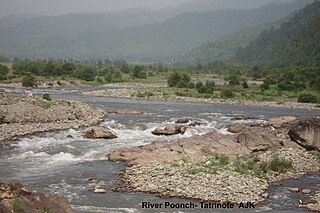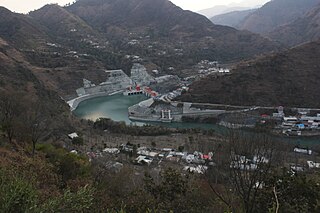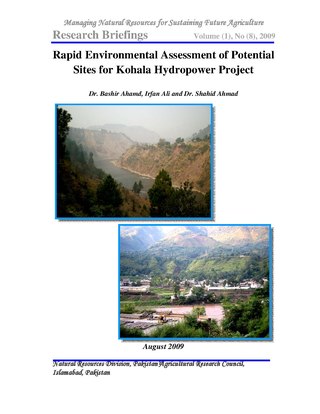
The Jhelum River (/dʒʰeːləm/) is a river in the northern Indian subcontinent. It originates at Verinag and flows through the Indian-administered territory of Jammu and Kashmir, into Pakistani-administered Azad Kashmir, then the Pakistani province of Punjab. It is the westernmost of the five rivers of the Punjab region, and flows through the Kashmir Valley. It is a tributary of the Chenab River and has a total length of about 725 kilometres (450 mi).

The Neelum River, or Kishanganga River, is a river in the Kashmir region of Pakistan and India. It originates in Ganderbal district of Jammu and Kashmir in India, flows through the Neelam Valley in Pakistan's Azad Kashmir, where parts of its course fall along the Line of Control, before merging with the Jhelum River near the city of Muzaffarabad.

The Poonch River is a tributary of the Jhelum River that flows through Jammu and Kashmir in India, and Jammu and Kashmir in Pakistan.

The Koldam Hydropower Station commonly known as Koldam, is an embankment dam on the Sutlej River upstream of the Dehar Power House. It is 18 km from Bilaspur off the Chandigarh-Manali Highway (NH-21) near Barmana, Himachal Pradesh, India. The main purpose of the dam is hydroelectric power generation and it will support an 800 MW power station. The dam was constructed by NTPC Limited.

The Neelum–Jhelum Hydropower Plant is part of a run-of-the-river hydroelectric power project in Azad Kashmir (AJK) designed to divert water from the Neelum River to a power station on the Jhelum River. The power station is located 42 km (26 mi) south of Muzaffarabad, and has an installed capacity of 969 MW. Construction on the project began in 2008 after a Chinese consortium was awarded the construction contract in July 2007. After many years of delays, the first generator was commissioned in April 2018 and the entire project was completed in August 2018 when the fourth and last unit was synchronized with the national grid on 13 August and attained its maximum generation capacity of 969 MW on 14 August 2018. It will generate 5,150 GWh per year at the levelised tariff of Rs 13.50 per unit for 30 years.
The Yayangshan Dam (崖羊山大坝) is a concrete-face rock-fill dam on the Lixian River, bordering the counties of Ning'er and Mojiang in Yunnan Province, China. It is located 56 km (35 mi) from Pu'er City. The primary purpose of the dam is hydroelectric power generation and it supports a 120 MW power station. Construction began in 2003, the river was diverted in 2004 and the two 60 MW generators were commissioned in 2006. It is the first dam in the Lixian River cascade.

China–Pakistan Economic Corridor (CPEC) is a 3000 km Chinese infrastructure network project undertaken in Pakistan. This sea-and-land based corridor is aimed to secure and reduce the passage for China's energy imports from the Middle East by avoiding existing route from the Straits of Malacca between Malaysia and Indonesia, which in case of a war could be blocked and thus hampering the Chinese energy dependent economic avenues. Developing a deep water port at Gwadar in Arabian Sea and a well built road and rail line from this port to Xinjiang Province in western China would be a shortcut for boosting the trade between Europe and China. In Pakistan, its aim is to overcome an electricity shortfall, infrastructural development and modernize transportation networks. Along with shifting it from an agricultural based economic structure to industrial based.

Patrind Hydropower Plant is a run-of-the-river, high head project of 110 metres (360 ft), located on Kunhar River near Patrind Village right on the border of Abbottabad District of Khyber Pakhtunkhwa Province and Muzaffarabad city of Azad Kashmir, Pakistan. It is approximately 138 kilometres (86 mi) from Rawalpindi and Islamabad and about 76 kilometres (47 mi) from Abbottabad city.
Gulpur Hydropower Plant (GHPP) is an operational run-of-the-river hydroelectric generation project located on Poonch River, a major tributary of Jhelum River near Gulpur in Kotli District of Azad Kashmir, Pakistan. The site is about 167 km from Federal Capital Islamabad and 285 kilometres (177 mi) from Punjab's Provincial Capital Lahore and is approachable directly from Islamabad and Lahore by a two-lane, all-weather, paved, partly mountainous road. The location of the project is about 28 km upstream of Mangla Dam Reservoir.

The Kohala Hydropower Project is a proposed run-of-the-river, high head project of 316 meters that will be located near Kohala, in Azad Kashmir. In 2020 the project's agreement was finalised later it was formally signed in a ceremony attended by the Pakistani Prime Minister Imran khan, and Chinese ambassador.
Xi Jinping's visit to Pakistan from 20 to 21 April 2015, was the first state visit of Xi Jinping to Pakistan. Xi is the second Chinese leader to visit Pakistan in 2010s after Chinese Premier Li Keqiang's visit to Pakistan between 22 and 23 May 2013. It was also Xi's first overseas trip of 2015. The trip led to the signing accords for $46 billion of investment in Pakistan by China for the construction of roads, rails and power plants to be built on a commercial basis by Chinese companies over 15 years. Most of the 51 projects were part of the China–Pakistan Economic Corridor.

The Azad Pattan Hydropower Project is a 700 MW hydroelectric power station on the Jhelum River roughly 7 km upstream of Azad Pattan Bridge in the Sudhanoti District, Azad Jammu and Kashmir, Pakistan and 90 km from Islamabad, the capital city of Pakistan. The project is scheduled for completion by 2026. In July 2020, the project's $1.5 billion investment agreement was signed between Chinese state-owned China Gezhouba Group and Pakistan, in a ceremony attended by Prime Minister Imran Khan and senior government ministers.
SK Hydro also known as Suki Kinari HPP, is an under-construction, run-of-the-river hydropower project located on the Kunhar river in the Kaghan valley of Mansehra District Khyber Pakhtunkhwa, which has an installed generation capacity of 884 MW.

Karachi–Peshawar Railway Line is one of four main railway lines in Pakistan, operated and maintained by Pakistan Railways. The line begins from Karachi City station or Kiamari station and ends at Peshawar Cantonment Station. The total length of this railway line is 1,687 kilometers (1,048 mi). There are 176 railway stations from Kiamari to Peshawar Cantonment on this line. The line serves as the main passenger and freight line of the country. 75% of the country's cargo and passenger traffic uses the line. The line is currently undergoing a six-year Rs. 1286.68 billion (US$4.5 billion) upgrade and renovation as part of the China Pakistan Economic Corridor, with average rail speeds expected be doubled to 160 kilometers per hour upon completion.
Nenskra Hydro Power Plant is a proposed hydroelectric power station to be located on the southern slopes of the Central Caucasus mountains in Svaneti, Georgia.











